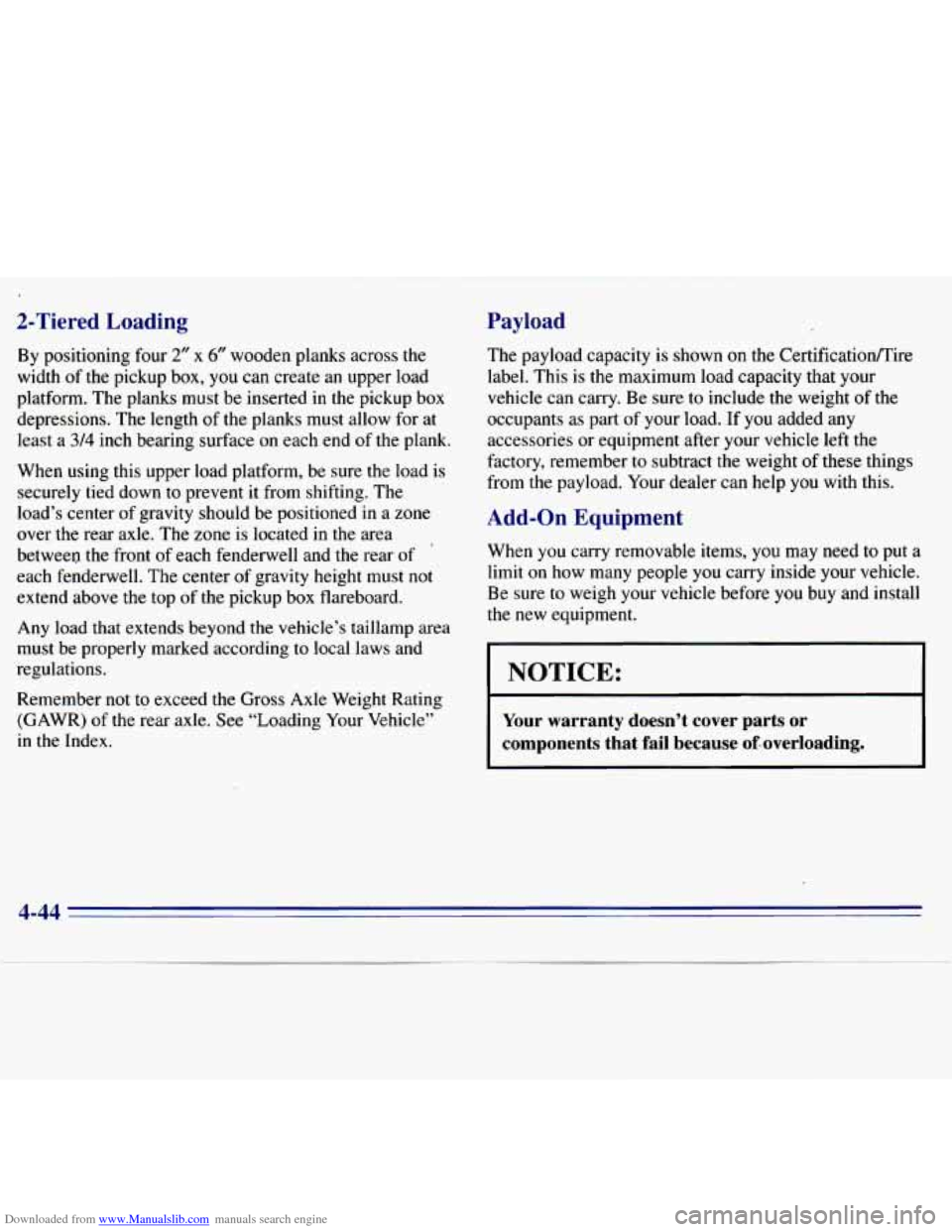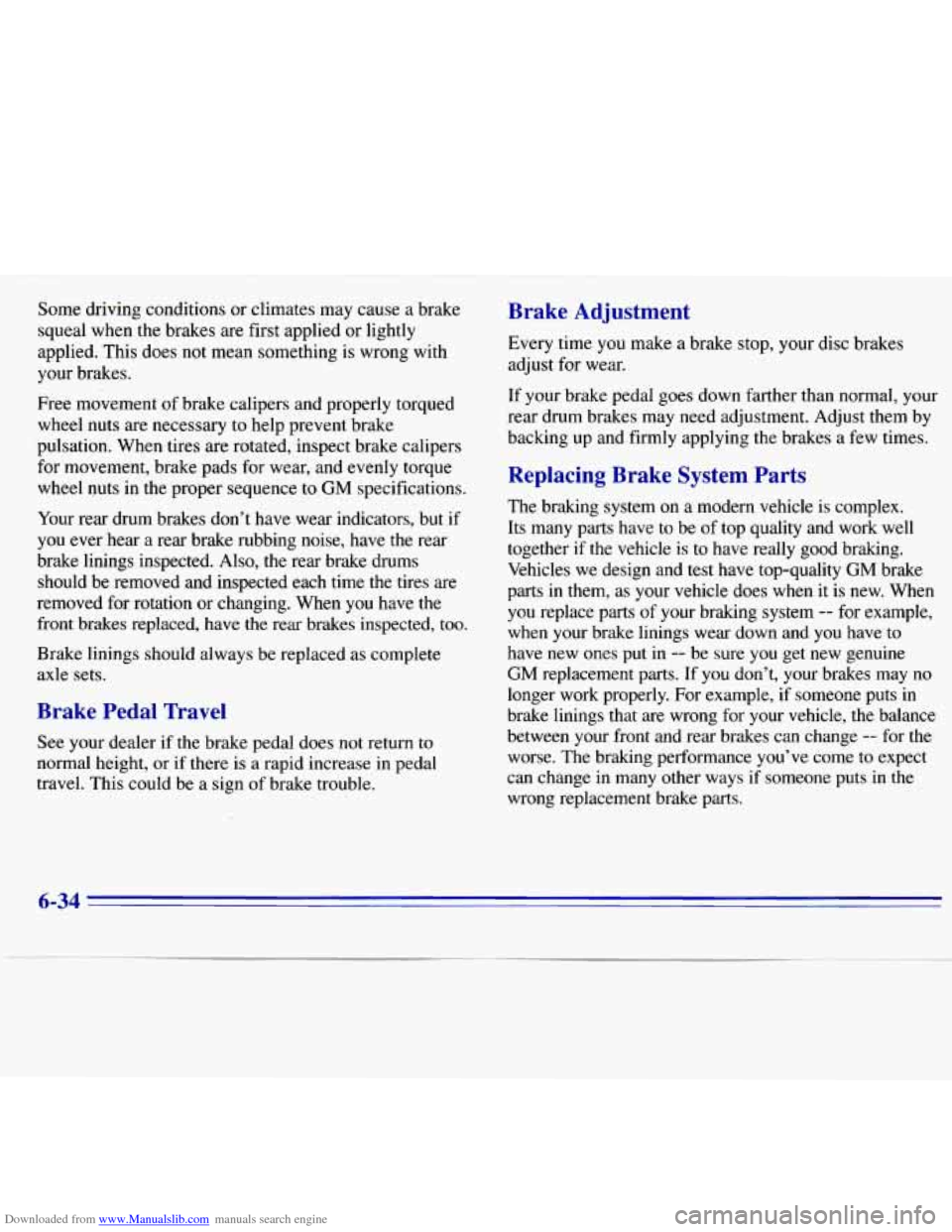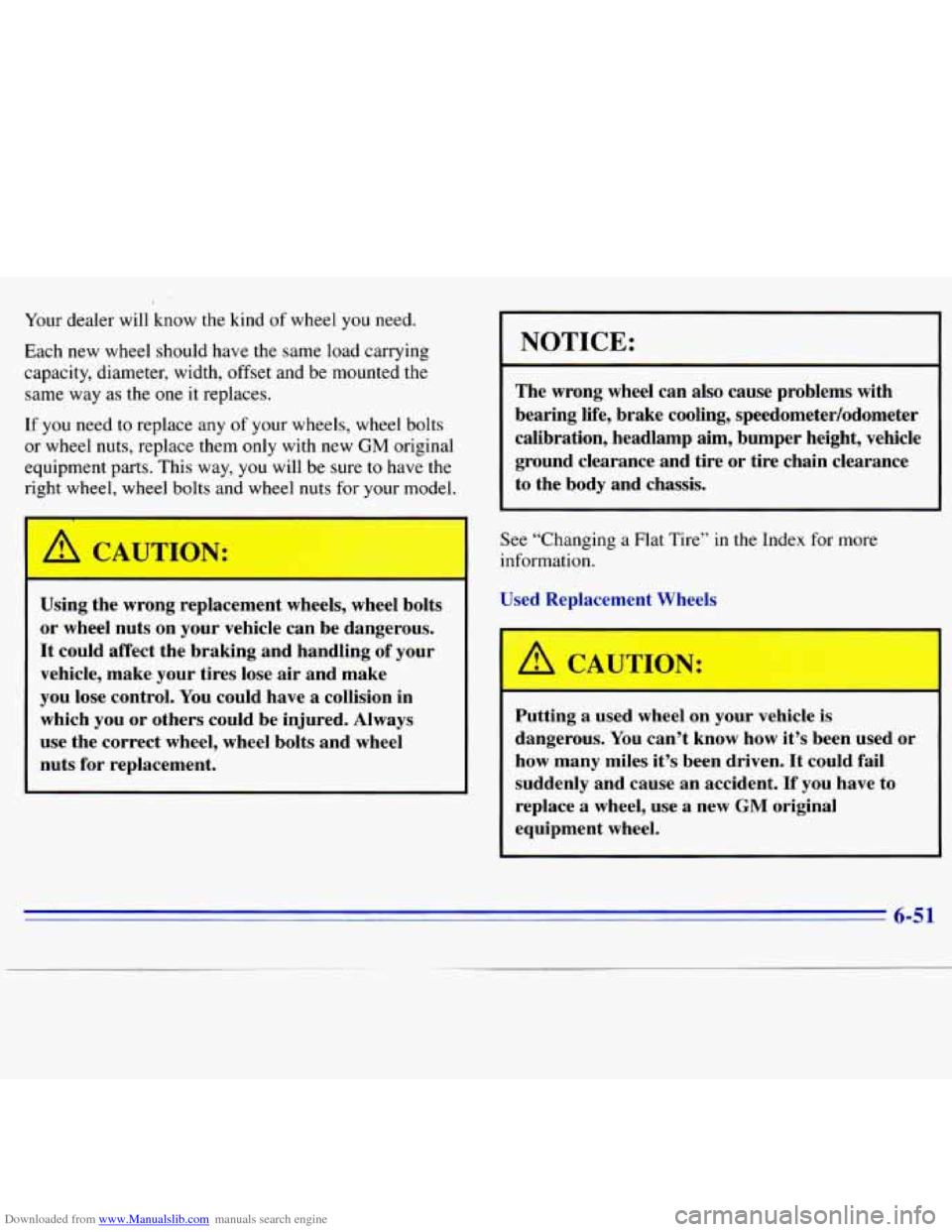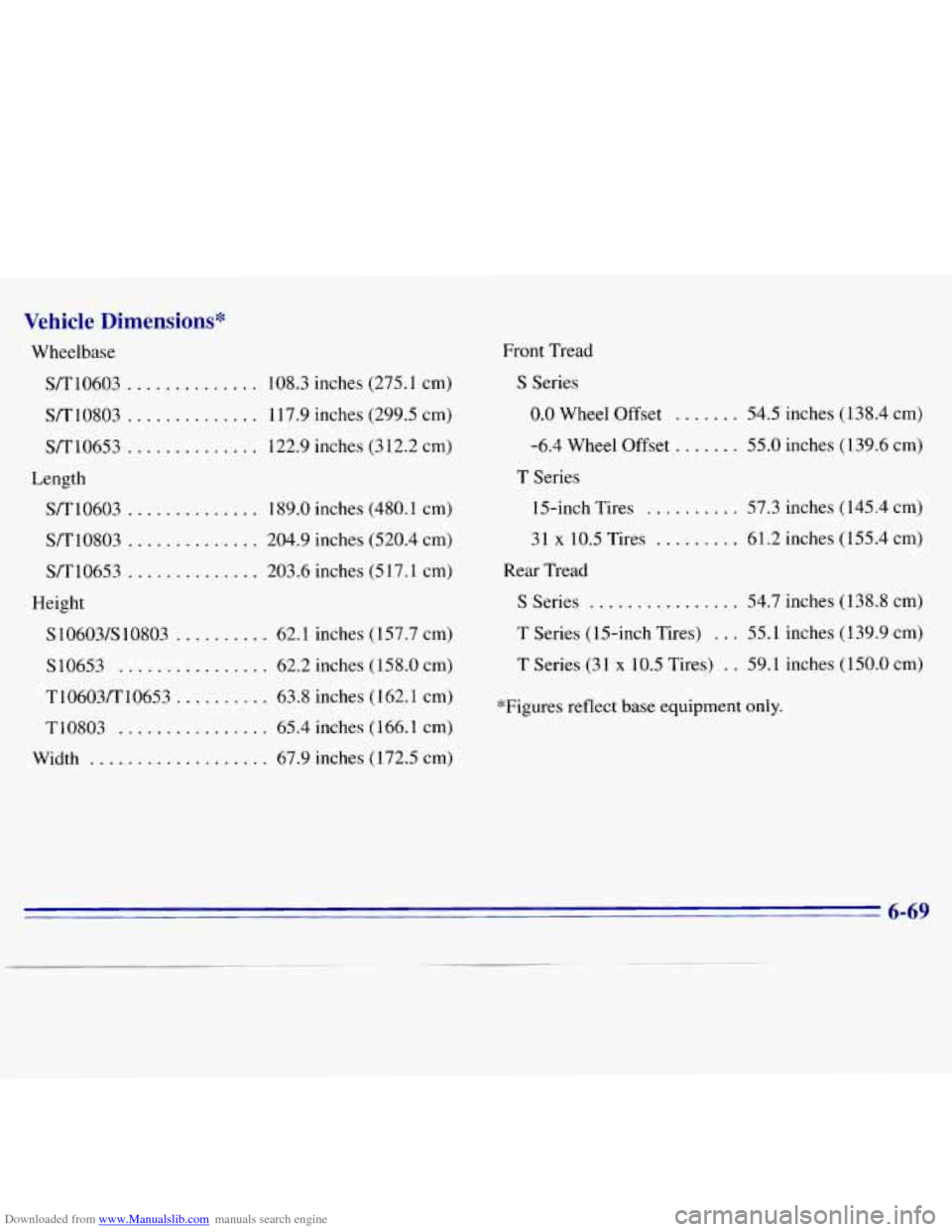1996 CHEVROLET S10 height
[x] Cancel search: heightPage 35 of 375

Downloaded from www.Manualslib.com manuals search engine Adding Equipment to Your
Air Bag-Equipped Vehicle
&= If I add a push bumper or a bicycle rack to the
. front of my vehicle, will it keep the air bag from
working properly?
A: As long as the push bumper or bicycle rack is
attached to your vehicle
so that the vehicle’s basic
structure isn’t changed, it’s
not likely to keep the
air bags from working properly
in a crash.
Is there anything I might add to the front of the
vehicle that could keep the air bag from
working properly?
A: Yes. If you add things that change your vehicle’s
frame, bumper system, front end sheet metal or
height, they may keep
the air bag system from
working properly.
Also, the air bag system may not
work properly if
you relocate any of the air bag
sensors.
If you have any question about this, you
should contact Customer Assistance before
you
modify your vehicle. (The phone numbers and
addresses for Customer Assistance are
in Step Two of
the Customer Satisfaction Procedure in this manual. See “Customer Satisfaction Procedure’’
in the Index.)
Safety Belt Use During Pregnancy
Safety belts work for everyone, including pregnant
women. Like all occupants, they are more likely
to be
seriously injured
if they don’t wear safety belts.
A pregnant woman should wear a lap-shoulder belt, and
the lap portion should be worn as low as possible, belou
the rounding, throughout the pregnancy.
1-24
Page 175 of 375

Downloaded from www.Manualslib.com manuals search engine 2-Tiered Loading
By positioning four 2” x 6” wooden planks across the
width of the pickup box, you can create an upper load
platform. The planks
must be inserted in the pickup box
depressions. The length of the planks must allow for at
least a
314 inch bearing surface on each end of the plank.
When using this upper load platform, be sure the load is
securely tied down to prevent
it from shifting. The
load’s center
of gravity should be positioned in a zone
over the rear axle. The zone is located
in the area
between the front
of each fenderwell and the rear of
each fenderwell. The center of gravity height must not
extend above
the top of the pickup box flareboard.
Any load that extends beyond the vehicle’s taillamp area
must be properly marked according to local laws and
regulations.
Remember not to exceed the Gross Axle Weight Rating
(GAWR) of the rear axle. See “Loading Your Vehicle”
in the Index.
Payload
The payload capacity is shown on the Certification/Tire
label. This is the maximum load capacity that your
vehicle can carry. Be sure to include the weight of the
occupants as part of your load. If you added any
accessories or equipment after your vehicle left the
factory, remember
to subtract the weight of these things
from the payload. Your dealer can help you with this.
Add-on Equipment
When you carry removable items, you may need to put a
limit on how many people you carry inside your vehicle.
Be sure to weigh your vehicle before you buy and install
the new equipment.
NOTICE:
I
Your warranty doesn’t cover parts or
components that fail because of, overloading.
4-44
~ .~ .
Page 260 of 375

Downloaded from www.Manualslib.com manuals search engine Some driving conditions or climates may cause a brake
squeal when the brakes are first applied or lightly
applied. This does not mean something is wrong
with
your brakes.
Free movement of brake calipers and properly torqued
wheel nuts are necessary to help prevent brake
pulsation. When tires are rotated, inspect brake calipers
for movement, brake pads
for wear, and evenly torque
wheel nuts in the proper sequence to
GM specifications.
Your rear drum brakes don’t have wear indicators, but if
you ever hear
a rear brake rubbing noise, have the rear
brake linings inspected. Also, the rear brake drums
should be removed and inspected each time the tires are
removed for rotation or changing. When
you have the
front brakes replaced, have the rear brakes inspected, too.
Brake linings should always be replaced as complete
axle sets.
Brake Pedal Travel
See your dealer if the brake pedal does not return to
normal height, or if there is a rapid increase in pedal
travel. This could be
a sign of brake trouble.
Brake Adjustment
Every time you make a brake stop, your disc brakes
adjust for wear.
If your brake pedal goes down farther than normal, your
rear drum brakes may need adjustment. Adjust them by
backing
up and firmly applying the brakes a few times.
Replacing Brake System Parts
The braking system on a modern vehicle is complex.
Its many parts have to be of top quality
and work well
together if the vehicle is to have really good braking.
Vehicles we design and test have top-quality
GM brake
parts
in them, as your vehicle does when it is new. When
you replace parts of your braking system
-- for example,
when your brake linings wear down and you have to
have new ones put in
-- be sure you get new genuine
GM replacement parts. If you don’t, your brakes may no
longer work properly. For example,
if someone puts in
brake linings that are wrong for your vehicle, the balance
between your front and rear brakes can change
-- for the
worse. The braking performance you’ve come
to expect
can change
in many other ways if someone puts in the
wrong replacement brake parts.
6-34
Page 277 of 375

Downloaded from www.Manualslib.com manuals search engine Your dealer will know the kind of wheel you need.
Each new wheel should have the same load carrying
capacity, diameter, width, offset and be mounted the same way as the one it replaces.
If you need
to replace any of your wheels, wheel bolts
or wheel nuts, replace them only with new
GM original
equipment parts. This way, you will be sure
to have the
right wheel, wheel bolts and wheel nuts for your model.
Using the wrong replacement wheels, wheel bolts
or wheel nuts on your vehicle can be dangerous.
It could affect the braking and handling
of your
vehicle, make your tires lose air and make
you lose control.
You could have a collision in
which you or others could be injured. Always
use the correct wheel, wheel bolts and wheel
nuts for replacement.
NOTICE:
The wrong wheel can also cause problems with
bearing life, brake cooling, speedometer/odometer
calibration, headlamp aim, bumper height, vehicle
ground clearance and tire or tire chain clearance
to the body and chassis,
See “Changing a Flat Tire” in the Index for more
information.
sed Replacement
7 keels
Putting
a used wheel on your vehicle is
dangerous. You can’t know how it’s been used or
how many miles it’s been driven, It could fail
suddenly and cause an accident.
If you have to
replace a wheel, use
a new GM original
equipment wheel.
6-51
Page 295 of 375

Downloaded from www.Manualslib.com manuals search engine Vehicle Dimensions"
Wheelbase S/T10603
.............. 108.3 inches (275.1 cm)
S/T10803
.............. 117.9 inches (299.5 cm)
S/T10653
.............. 122.9 inches (312.2 cm)
Length
S/T 10603 .............. I 89.0 inches (480.1 cm)
S/T10803
.............. 204.9 inches (520.4 cm)
S/T10653
.............. 203.6 inches (517.1 cm)
Height
S10603/S10803
.......... 62.1 inches (157.7 cm)
SI0653
................ 62.2 inches (158.0 cm)
T10603/T10653..
........ 63.8 inches (162.1 cm)
T10803
................ 65.4 inches (166.1 cm)
Width
................... 67.9 inches (172.5 cm) Front
Tread
S Series
0.0 Wheel Offset ....... 54.5 inches (138.4 cm)
-6.4 Wheel Offset
....... 55.0 inches (139.6 cm)
T Series
15-inch Tires
.......... 57.3 inches (145.4 cm)
3 1
x 10.5 Tires ......... 61.2 inches (155.4 cm)
Rear Tread
S Series ................ 54.7 inches ( 138.8 cm)
T Series (15-inch Tires)
... 55.1 inches (139.9 cm)
T Series (3 1
x 10.5 Tires) . . 59.1 inches (150.0 cm)
*Figures reflect
base equipment only.
6-69